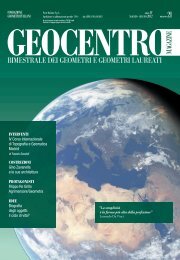Geocentro Magazine - Fondazione Geometri
Geocentro Magazine - Fondazione Geometri
Geocentro Magazine - Fondazione Geometri
You also want an ePaper? Increase the reach of your titles
YUMPU automatically turns print PDFs into web optimized ePapers that Google loves.
66<br />
ANNO II | n. 7 | GENNAIO - FEBBRAIO 2010<br />
Mappa che mostra i siti delle misurazioni di Pierre Louis Moreau<br />
de Maupertuis eff ettuate durante la sua spedizione in Lapponia, da<br />
"La Figure de la Terre" (1738)<br />
Map showing the sites of Maupertuis's measurements from his expedition<br />
to Lapland, from "La Figure de la Terre" (1738)<br />
Due anni dopo, in virtù della maggiore incertezza nella<br />
determinazione delle longitudini, si opta per la misura di<br />
archi di meridiani a differenti latitudini e, per iniziativa<br />
dell’Académie Royale des Sciences de Paris, vengono<br />
finanziate due celebri spedizioni in Lapponia ed in Perù.<br />
Parte prima la spedizione del Perù (1735), con Louis Godin<br />
(1704 - 1760), Charles-Marie de La Condamine (1701 -<br />
1774) e Pierre Bouguer (1698 - 1758), e l’anno seguente<br />
quella della Lapponia (1736), condotta da Pierre-Louis<br />
Moreau de Maupertuis (1698 - 1759). Grazie a queste<br />
epiche imprese la teoria newtoniana viene definitivamente<br />
confortata dai dati empirici ed universalmente riconosciuta<br />
come valida: la Rivoluzione geodetica è avviata e la<br />
cartografia si apre a nuovi ed inimmaginati scenari.<br />
Il passaggio successivo verso la realizzazione di cartografia<br />
geometrica alla scala topografica per i più ampi ambiti<br />
territoriali avviene poi in virtù delle crescenti esigenze di<br />
controllo militare del territorio (che nel frattempo ha<br />
allungato la gittata dei pezzi di artiglieria e necessita di<br />
strumenti matematici per il controllo del tiro) ed in seguito<br />
increasing demand for military control (in the meanwhile<br />
the range of the artillery was improved and more precise<br />
mathematical instruments were needed in order to direct<br />
the shots) and, thereafter, to the urgent need for a fiscal<br />
equalization, based on the ownership of real estates, as suggested<br />
by the Illuminist Physiocratic theories.<br />
The first great laboratory for the application and the teaching of<br />
the systematic survey of the land on large-scale became a reality<br />
with the creation of the geometric cadastre based on parcels<br />
in Milan (or Cadastre of Maria Theresa). Although with<br />
its scientific limitations, due to the lack of a specific geodetic<br />
reference system that could support it, this surveying was able to<br />
accomplish a careful work in a deepest knowledge of the ducal<br />
territory. Under the guide of the mathematician Giovanni<br />
Giacomo Marinoni (1676-1755), a great improvement in<br />
the professional training was achieved: a new generation of<br />
topographers and cartographers was created, all able to make<br />
use of the plane table and to observe the strict rules of the<br />
topographical design.<br />
A member of this multitude is the “eminent surveyor” from<br />
Giovanni Battista Nolli<br />
"Nuova Topografi a di Roma"<br />
Particolare<br />
Giovanni Battista Nolli<br />
"Th e New Plan of Rome"<br />
Detail






